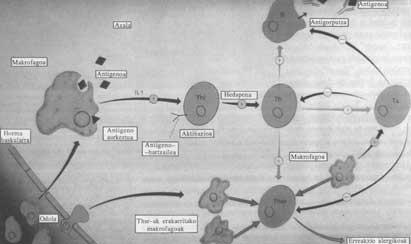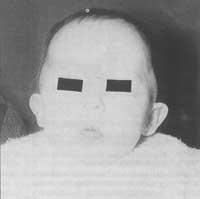Immune system: protection of external attacks
Introduction Introduction Introduction Introduction
Until recently we knew nothing of the systems that our body used to defend us from external attacks. Although in recent years Immunology has advanced a lot, there are still many things in the air.
If we analyze in depth what this defense means, immediately one thing comes to mind: Our body must differentiate well what is theirs in order to face all the aggressors that come from outside.
How does our body fulfill such a complex function? What happens in this system in case of failure?
In the following lines we will try to know more about all these problems. However, given the complexity of the subject, we will explain all things with quite simplification.

Two main systems
During phylogenetic evolution, animals, like many other body systems, have significantly improved the immune system.
Therefore, the only defense system that appears until reaching vertebrates is the so-called NONSPECIFIC IMMUNITY.
Among the most important elements involved in this system are skin, phagocytic cells (macrophages and microphages) and some humoral factors (lysozima, PCR, complement, interferons).
However, it is a system that manifests itself from the vertebrate systems that interest us and is known as SPECIFIC IMMUNITY. Since in reality both systems are very related, although this division is very relative, when analyzing them it is of great value.
The main differences between both systems are the four main properties of the specific system:
- CELL BASE: Its function is based on lymphocytes type “B” and “T”, a type of white blood cell present in our blood. While other white blood cells are responsible for unspecific immunity, the only role of lymphocytes is specific immunity. Although within them we have distinguished those of type “B” and “T”, it is important to differentiate among those of type “T” those of type “T-4” and “T-8”. While the former are called “cooperators”, the latter are “suppressors or cytotoxic”.
- SPECIFICITY: Throughout the ontogenic evolution, these cells acquire SPECIFIC RECEPTORS (see n° 21 immunology of transplants). Through these receptors each cell acquires the ability to relate specifically to one or few substances (and very similar) present in the medium. It is said that this cell and those born from it by division form a CLON.
- LATENCY: The Antigen (any molecule that can provoke the reaction of our immune system and react with its effects) spends a specific time until it enters our body and gives response.
- MEMORY: When the antigen enters for the first time, latency is several days and the first antibodies to form (see t21) are of the type Ig-M. When entering the second stage, the latency decreases considerably; the antibodies that enter first are of the type Ig-G, its specificity is greater and its number.
This is the effect sought with vaccines. Create memory in the defense system with viruses dead or weakened or with specific antigens of bacteria, so that when the actual microorganism arrives the response is much stronger, the infection will not occur and even if it occurs, it will be much smoother.

Lymphocytes B
The main peculiarity of lymphocytes is their ability to antibodies. When they contact the antigen, some changes make it PLASMA CELLS that can form antibodies. Although some antigens can directly activate B cells, in most cases their activation requires the help of the “T-4” lymphocytes (called dependent last antigens).
Plasma cells can form antibodies of five types: Ig-G, Ig-M, Ig-A, Ig-E and Ig D. However, we will not begin to analyze the particularities of each one.
Antibodies have a protein structure that can be specifically associated with the antigen that has originated them. Normally they are not able to destroy it and perform their defensive function by activating the inspecific system, which is the one that disappears the strange substance (especially by phagocytosis).
In recent times monoclonal antibodies have been obtained using complex techniques, that is, antibodies of own chemical structure that will join the same antigen. Its applications can be still very important, although unfortunately most of them are science fiction: a/ Purification of certain molecules (interferons, interleukins...) b/ Diagnosis and control of tumors and infections (Note: Perhaps the last article by Jorge Ochoa refers to this). c/ Organ transplantation, which would be directed against the defenses that attacked the transplanted organ. d/ Control of autoimmune diseases, addressing the defenses causing the disease. d/ Others: as a genetic marker, agronomy, etc.
T lymphocytes

As mentioned above, there are two types. Those of type “T-4” need to react that the antigen is associated with an antibody type HLA-II (see t21). Therefore, normally the presentation of the antigen is done by a macrophage. T-4 lymphocytes are not able to destroy the antigen, their action is done by B lymphocytes and macrophages. Lymphocytes B and macrophages cause the same T-4 lymphocytes.
The peculiarity of these T-4 lymphocytes is a receptor called CD4 that is associated with the AIDS virus in the cell membrane. It is then inserted into the inside of the lymphocyte, where it can be infected (but not sick) for a long time. When another infection affects the evolution of these T-4 lymphocytes, the virus "wakes up" and removes lymphocytes infected by the infected patient (although the pathway is not well known, it is believed that others not infected also destroy them). Taking into account the importance of T-4 lymphocytes in the effect of B lymphocytes, it is not difficult to understand that the defense system is very small in this friend.
T-8 lymphocytes require the reaction antigen to appear associated with an antibody type HLA-I. Their function, as its name indicates, is on the one hand suppressing (thus putting some control to the immune reaction), and on the other, they can perform a cytotoxic action without the help of the inspecific system.
Once a somero analysis of the functioning is performed, we will analyze the pathologies that derive from their alterations. The pathology can be divided into three groups: on the one hand, when there is an insufficiency of the immune system, on the other, at the time when the immune system is directed against them without recognizing the components of our body and, finally, it reacts to substances that normally do not react.
Immunodeficiencies
Any pathology that alters this complex defensive system will undoubtedly have serious consequences for the body.
Immunodeficiencies can be of two types: congenital or acquired. Among the first there are many types depending on the degree of alteration. The second best known is AIDS, but we cannot forget those that occur in oncological and transnplating treatments.
Although the clinic will vary depending on the degree of alteration, undoubtedly the most remarkable of all manifestations will be the area of infections.
Therefore, if the alteration is in B cells, respiratory infections predominate: H. influenzae, Neumococo, Streptococcus, Meningococo, Staphylococcus, etc... If the alteration occurs in “T” cells, infections are due to viruses (herpes, chickenpox, cytomegalovirus...), fungi (candidiasis) and protozoa like Neumocystis carinii.
In addition, neoplasms are more frequent in these people than in the normal population, and surprisingly autoimmune based diseases.

Autoimmune diseases
We can define autoimmune disease as the pathology that is introduced when the defensive system begins to act against one or more organs of our body.
It is not clear what are the causes of this fact, but in some diseases it has been observed that there is a clear relationship between the disease and autoimmune antibodies in blood.
These antibodies can go against a specific organ or against a set of organs, with a very different clinic. Among the first groups can be cited severe myasthenia, juvenile diabetes, and similar. In the second can be cited rheumatoid arthritis, Sjgen disease, or systemic lupus erythematosus.
Allergic diseases Allergic diseases
At the beginning of this century we began to know what antibodies are. Although initially it was considered that its only function was protection, in 1902 RICHET and PORTIER worked with marine anemones, they found that the second immunization of dogs by poison could be the cause of serious injuries. This effect was called ANAFILAXIA (from the Greek ana = against, filaxia = protection).
Since then, many similar phenomena have been described, but in all of them no antibodies are involved. In 1906 VON PIRQUET joined them under the name of ALLERGIES (From Greek: anomalous reactions).

Among all types, due to their importance in the clinic, we will explain the foundation of IMMEDIATE HYPERSENSITIVITY.
In 1923 COCA took the word ATOPIA to express the previous tendency of these individuals to immediate hypersensitivity to the different substances of their environment.
If the normal reaction to external attacks is the introduction of antibodies of the type Ig-M (primary response) or of the type Ig-G (secondary response), these friends create those of the type Ig-E and also antigens that do not generate response in other people (dust, pollen, penicillin, ...).
These Ig-E are anchored in the mast cell membrane (cells of the non-specific system). This step is called SENSITIZATION.
In the second phase, when this friend contacts the substance that has made the sensitization, he will release several chemical intermediaries that the mast ocyte has inside, guilty of the entire clinic.
The consequences vary according to where the antigen enters. Thus respiratory allergens (pollen, spores, acarides, etc.) Symptoms of the respiratory tract (mainly asthma), drugs administered with vein such as anaphylactic shock, etc.
As we said at the beginning, although Immunology is a very new science, seeing everyone who is working, there is no doubt that within a few years there will be important discoveries and discoveries.
Although its application will benefit from a lot of medicine, it will have a great influence on many other sciences.





